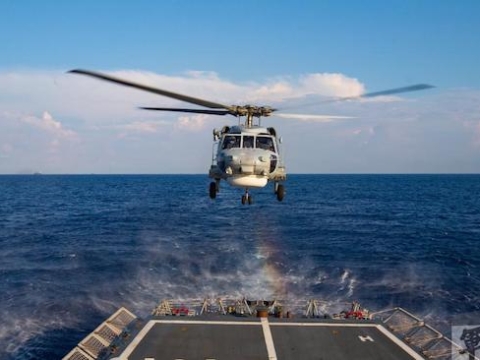
The Pulse of the Indo-Pacific with Former Assistant Secretary of Defense Randy Schriver
August 2, 2021
U.S. Will Learn Lesson From Afghanistan and Bolster Support for Taiwan, Expert Says
August 20, 2021PLA Reform, Reorganization, and U.S.-China Military-to-Military Relations
(Soldiers of the Chinese People's Liberation Army 1st Amphibious Mechanized Infantry Division prepare to provide Chairman of the Joint Chiefs of Staff Adm. Mike Mullen with a demonstration of their capablities during a visit to the unit in China on July 12, 2011. Source: The U.S. "Department of Defense"/ Mass Communication Specialist 1st Class Chad J. McNeeley.)
By: Grace Young, Eric Lee, and Mark Stokes |
Five years ago, the Chinese Communist Party (CCP) Central Military Commission (CMC) initiated a large-scale reorganization of the People’s Liberation Army (PLA), People’s Armed Police, and militia. Among many drivers, the CMC likely sought to expand party control over all CMC organs. However, they also sought to separate command and administrative functions. The reform program has included consolidation of the PLA’s fragmented research, development, and acquisition (RD&A) system and signaled intent to challenge traditional U.S. dominance of the electromagnetic spectrum and other warfighting domains.
The CMC also restructured its joint military command and control system, which should facilitate transition to higher states of operational readiness. With a new separation of command and administrative functions, the PLA has streamlined its command and control while simultaneously reaping the benefits of departmental specialization in its military RD&A system. Beijing is therefore better positioned to achieve its military modernization objectives. This restructuring has helped the PLA field new systems and capabilities faster than before.
Other aspects of the reform and reorganization remain enigmatic. The CMC and PLA have a long history of purposeful and tightly controlled interactions with foreign defense and military intelligence establishments. Until the 1990s, the CMC, presumably through the General Office, empowered the former General Staff Department (GSD) Intelligence Department (also known as the GSD Second Department) to manage formal state-to-state military exchanges on its behalf. The director of the GSD Second Department Foreign Affairs Bureau (FAB) carried a division leader grade and nominal Ministry of National Defense title for purposes of state interactions with foreign defense and military counterparts.
A Deputy Chief of the General Staff carrying a military region grade was assigned the intelligence and foreign affairs portfolio and oversight of the Second Department and Foreign Affairs Office (FAO). He also served as a member of the two leading small groups responsible for foreign and Taiwan affairs.
At the same time, the CMC General Office empowered the General Political Department (GPD) to carry out clandestine, coercive, and often corrupt exchanges with foreign opinion leaders, agents of influence, and senior advisors to serving officials. Guided by the concept of “uniting with friends and disintegrating enemies,†GPD military liaison work was, and likely continues to be, critical in shaping the security environment during peace and subverting an enemy’s national will in its coercive use of military force. The GPD Liaison Department (GPD/LD) managed Taiwan-focused propaganda and covert media placement in foreign outlets. However, a GPD Propaganda Department bureau also functioned as the Ministry of Defense Spokesman Office. The PLA’s security apparatus, which was also a GPD function, became more sensitized in the wake of the arrest of Second Department director Ji Shengde and defection of Senior Colonel Xu Junping to the United States in 2001.[1]
In January 2016, the CMC announced the establishment of a new Office of International Military Cooperation (OIMC).[2] As an example of a “one entity, two signboards†practice, the CMC/OIMC continues to maintain a dual function in conjunction with the Ministry of National Defense.[3] However, the OIMC no longer appears to have an administrative subordination to GSD’s successor, the CMC Joint Staff Department.
GPD/LD appears to have remained intact, despite rumors of its alleged absorption by the Central International Liaison Department. Its function now resides with the CMC Political Work Department Liaison Bureau. Due to the covert nature of its operations, little is known about military liaison work, its relationship with the PLA foreign affairs system, and processes and policies for dealing with foreign defense establishments. While unclear, a formal mechanism exists to coordinate among the three key players – the OIMC, CMC Joint Staff Department, and CMC Political Work Department – as well as with foreign affairs staffs of the CMC Equipment Development Department, PLA Army, Air Force, Navy, Rocket Force, and Strategic Support Force.
Long-Term Implications
The CMC reform and reorganization have radically changed the PLA, provided a structure to introduce increasingly capable weapons systems, and introduced a more rational command and control system. Despite its former GSD subordination, the FAB/FAO was reluctant to engage the U.S. Department of Defense in routinized operational exchanges. Routine operational dialogue is said to be important for signaling, developing better strategic assessments, and reducing the risk of accidents that can escalate out of control. Routinized defense engagements are also important for countering PLA political warfare and perception management.
Five years on, the PLA reforms have already had a global and lasting impact. CMC Chairman Xi Jinping has consolidated control over a more powerful PLA. However, the implications of the reform for relations between the U.S. and PRC defense enterprises is uncertain. Routinized military engagements between the U.S. and China may offer insights into the inner workings of an opaque and likely increasingly capable PLA able to use force in a range of contingencies around its periphery.
ENDNOTES
[1] John Pomfret, “Senior Chinese Military Officer Defects to U.S.,†The Washington Post, March 23, 2001, at https://www.washingtonpost.com/archive/politics/2001/03/23/senior-chinese-military-officer-defects-to-us/10fdce8d-8722-4a7f-b7de-af7f870497b8/.
[2] The Ministry of National Defense Foreign Affairs Office (MND/FAO) is ä¸åŽäººæ°‘共和国国防部外事办公室 in Chinese, and the Office of International Military Cooperation (OIMC) is ä¸å¤®å†›å§”国际军事åˆä½œåŠžå…¬å®¤.
[3] The Ministry of National Defense Office of International Military Cooperation (MND/OIMC) is ä¸åŽäººæ°‘共和国国防部国际军事åˆä½œåŠžå…¬å®¤ in Chinese. The PLA General Staff Department Foreign Affairs Bureau (also known as the PLA Second Department Third Bureau) is ä¸å›½äººæ°‘解放军总å‚谋部外事局 in Chinese.




